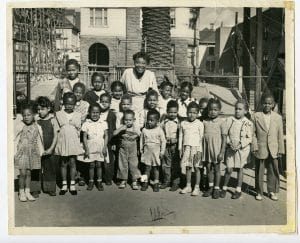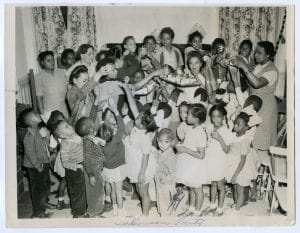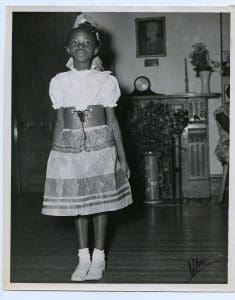“Seek the child not wanted, the child not loved, the child not guided. – Seek the child with a problem, preventing a problem child.”
The Fannie Wall Children’s Home and Day Nursery was an organization that offered social service needs to African American children in Oakland. The Children’s Home -- a residence for at risk youth and day care center for working mothers. It was established in 1914 by the Northern Federation of California Colored Women’s Club. After years of fundraising, the home opened on November 20, 1918, in West Oakland. The Club ran the Home until 1941.
The initial building was purchased in 1918 at 1215 Peralta Street. After outgrowing this location, the Home moved to 815 Linden Street where it remained until 1962. The 815 Linden Street property was torn down to make way for the Acorn Projects.
The next and final destination for the Home was at 647 55th Street.
The Homes purpose was “to take care of destitute poor minor orphans of both sexes, also destitute poor working girls; to provide for them a home, food and clothing; to nurse, attend and watch them when sick; and to procure, obtain and collect donations of money, food, clothing and property in furtherance of the objects of said Corporation.”
Clientele included children who were orphaned, neglected, homeless who demonstrated “some degree of emotional disturbance, family relationship difficulties, or difficulties with authorities.”
Around the turn of the century attitudes towards integrated children’s homes began to change. These institutions began to segregate as southern prejudicial attitudes moved west. The Fannie Wall Children’s Home became the only location in Oakland that accepted African American children. As a result, children from Alameda, San Francisco and Solano counties found themselves utilizing the services of the Home. Ironically, the Fannie Wall Children’s Home’s neighbor was the St. Vincent’s Day Home, a home that would not accept persons of color. Just as was the case with churches and schools, African Americans found the need to create parallel organizations to counter white establishments that did not welcome Blacks.
With the start of World War II and the Great Migration, the African American population of West Oakland increased substantially. As a result, the majority of the homes clientele were primarily children that were African American.
The Fannie Wall Home was an important institution which assisted children of color when no other institutions would provide assistance. For this reason, children from Alameda, Marin, Contra Costa and San Francisco Counties Public Welfare Departments, Alameda and San Francisco Juvenile Halls, and County Probation departments would utilize the residential services of the Fannie Wall Home.
The annual report noted many had “records of defiance, expulsions, and sometimes incorrigibility.” Many of the children were “beyond their parents’ control.”
If a child “hinders the progress of the other children, then we are morally obligated to release such a child to the care of such an agency which specialized in that type of disturbance.
The Home’s goal was treatment, rehabilitation and the return of residents to their primary homes. If the residents were unable return home, either a suitable place for specialized behavioral treatment was found or the children entered the foster care system. If the resident violated probation they were returned to Juvenile Hall. By providing physical, mental, and emotional care, the home provided the love that children may not have received in their own homes.
The Home utilized the services of an experienced social worker in dealing with children’s emotional needs. In fact, it was the first of its type in the city to use the services of a professional social worker.
The Home received support in a variety of ways. In 1923 it became the first organization that served children to become a part of the Oakland Community Chest -- voluntary agencies set up to helped those in need. Money came in to the Chest through a yearly campaign and was distributed to more than 40 other support agencies. For every dollar given by the Community Chest, the Home was required to provide matching funds. The organization utilized donations, nursery fees, and membership dues to run the Home.
Donations came from fundraising events, dinners, musicals, charity balls and memberships. From the Annual Raisin Day Dinner to the Annual Fannie Wall Ball these annual fundraisers were held to benefit the day-to-day operations of the Home.
The Home was full of activities and events throughout the year. Some of the traditions the children looked forward to were the monthly birthday parties, skate parties, weekly trips to the movies, and dances. Girls were also trained in the art of modern dance and charm.
A child’s day consisted of “experimentation, imaginativeness and creativeness through music-singing and interpretative dancing, painting-easel and finger, and block building.” The group also made trips twice a week to Oakland libraries West Oakland Branch for Story Hour. A typical weekly schedule for the children included:
Monday: visits away from Home with field trips to beach and park
Tuesday: game days
Wednesday: story and dramatics (residents would read or tell a story and recreate the story in skits)
Thursday: Art Day
Friday: music, songs and folk dancing.
Students used their creativity to make bookends, pin cushions, doll dresses and so much more. They also joined the Girl Scouts and the Oakland YWCA.
The Fannie Wall Children’s Home on Linden Street closed in 1962 after it was purchased by the Oakland Redevelopment Authority. The purchase made way for the Acorn Housing Projects. After moving to 55th Street and making extensive renovations, the location reopened as a childcare center. The Home closed in 1970 after a buyout by the Oakland Redevelopment Agency and thereafter reopened as a head start in 1978. The Home portion of the organization was discontinued as attitudes about the institutionalization of children in orphanages changed.
Today the former Fannie Wall Children’s Home is the Fannie Wall Head Start Center. It is located at 647 55th Street in Oakland.






Add a comment to: Remembering the Fannie Wall Children’s Home